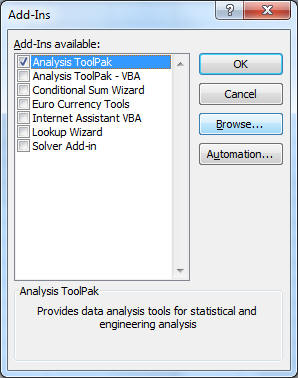
- #HOW TO GET DATA ANALYSIS TOOL IN EXCEL FOR MAC HOW TO#
- #HOW TO GET DATA ANALYSIS TOOL IN EXCEL FOR MAC FOR MAC#
- #HOW TO GET DATA ANALYSIS TOOL IN EXCEL FOR MAC UPDATE#
- #HOW TO GET DATA ANALYSIS TOOL IN EXCEL FOR MAC MAC#
In Quick Analysis Toolbar, the options will available under 5 categories. Note: You should know that the Quick Analysis tool won’t appear if you select an entire row or column as well as empty cells. Now, you can switch between the tab and click on the option to create a visualization. Once you click the icon, the tool will show you a galley of data analysis options you can use. You can also press Ctrl+ Q (Windows) or Command+ Q (MAC) after selecting the data to open the tool. Then, simply click on the Quick Analysis icon to reveal the options. To access the Quick Analysis Tool, select a range of cells or a data table and the Quick Analysis button will appear in the bottom-right corner of the selection as shown below. It can only appear only after selecting the data you want to analyze.

If you are looking for the Quick Analysis Tool in the Excel Ribbon, you won’t find it there.
#HOW TO GET DATA ANALYSIS TOOL IN EXCEL FOR MAC HOW TO#
Where is Quick Analysis Tool in Excel and How to Access it? In addition to that, the tool also suggests visualization methods that best fit your data, which is helpful for users who aren’t familiar with Excel or are new to Excel.Įxcel’s Quick Analysis feature is available only for Excel 2013 and later versions. In this article, we will see how to analyze your data using Quick Analysis Tool and insert charts, visualizations, various formatting options, summary formulas, tables, and sparklines. It makes it easier to quickly analyze the data set of any size and visualize it with the click of a button. Quick Analysis Tools saves you the trouble and time of searching through different tabs and command groups to access various analysis options. Quick Analysis Tool is one of the most useful tools in Microsoft Excel that allows you to instantly analyze your data and convert it into charts, tables, summaries, and sparklines as well as apply conditional formatting to your data.
#HOW TO GET DATA ANALYSIS TOOL IN EXCEL FOR MAC MAC#
Note: You may still need to adjust your scripts to reflect the notion of a file path on Mac (e.g., /Users/USERNAME/Desktop/data.csv) that is different than a file path on Windows (e.g., C:\Users\USERNAME\Desktop\data.csv).Use the Quick Analysis Tool in Excel to quickly analyze and visualize your data with charts, tables, sparklines, formatting, etc.
#HOW TO GET DATA ANALYSIS TOOL IN EXCEL FOR MAC FOR MAC#
Any existing macros and VBA scripts that reference Workbook.Queries and WorkbookQuery entities in the Excel's object model will work in Excel for Mac as expected. With this update, you can also create and manage Power Query queries in your workbook using VBA.

#HOW TO GET DATA ANALYSIS TOOL IN EXCEL FOR MAC UPDATE#
Click the Data tab on the ribbon > Connections > select the desired connection > and click Change File Path button to update it. Please note that upon the first time you try to refresh your workbook queries, you may need to update the location of the data source so that it works on your Mac.

Today, we are excited to announce the first step in a journey to support Power Query in Excel for Mac. These tools, based on Power Query technology, enable you to easily connect, combine, and shape data coming from a variety of sources.

Excel 2016 for Windows introduced a powerful set of Get & Transform Data tools.


 0 kommentar(er)
0 kommentar(er)
